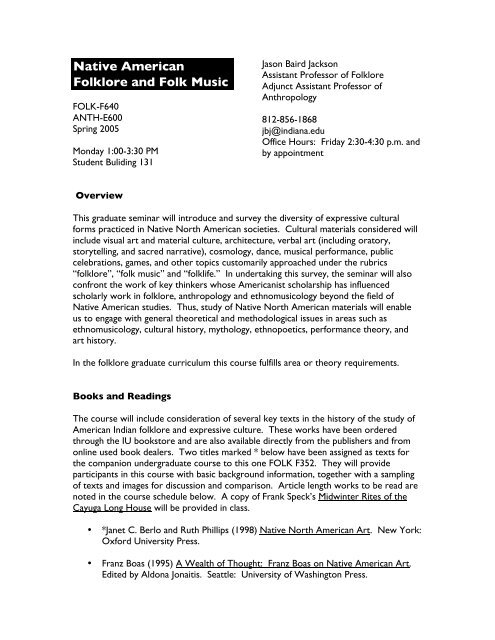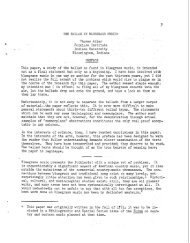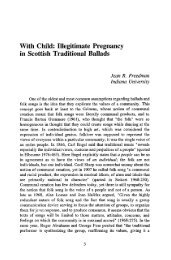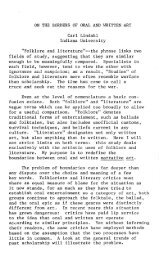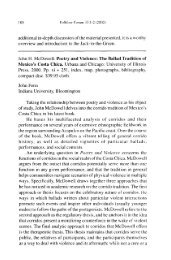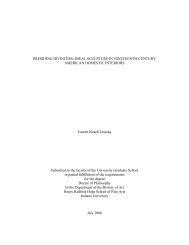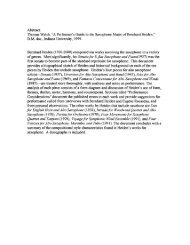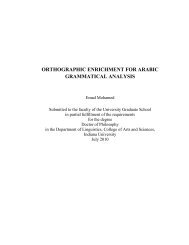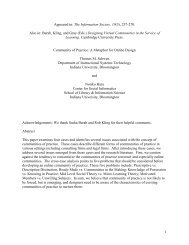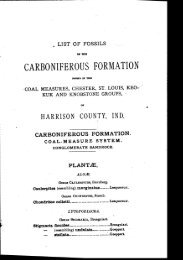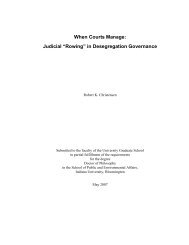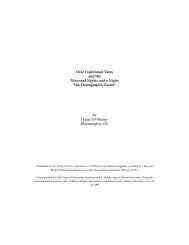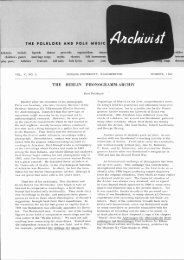Native American Folklore and Folk Music - Indiana University
Native American Folklore and Folk Music - Indiana University
Native American Folklore and Folk Music - Indiana University
Create successful ePaper yourself
Turn your PDF publications into a flip-book with our unique Google optimized e-Paper software.
<strong>Native</strong> <strong>American</strong><br />
<strong><strong>Folk</strong>lore</strong> <strong>and</strong> <strong>Folk</strong> <strong>Music</strong><br />
FOLK-F640<br />
ANTH-E600<br />
Spring 2005<br />
Monday 1:00-3:30 PM<br />
Student Buliding 131<br />
Overview<br />
Jason Baird Jackson<br />
Assistant Professor of <strong><strong>Folk</strong>lore</strong><br />
Adjunct Assistant Professor of<br />
Anthropology<br />
812-856-1868<br />
jbj@indiana.edu<br />
Office Hours: Friday 2:30-4:30 p.m. <strong>and</strong><br />
by appointment<br />
This graduate seminar will introduce <strong>and</strong> survey the diversity of expressive cultural<br />
forms practiced in <strong>Native</strong> North <strong>American</strong> societies. Cultural materials considered will<br />
include visual art <strong>and</strong> material culture, architecture, verbal art (including oratory,<br />
storytelling, <strong>and</strong> sacred narrative), cosmology, dance, musical performance, public<br />
celebrations, games, <strong>and</strong> other topics customarily approached under the rubrics<br />
“folklore”, “folk music” <strong>and</strong> “folklife.” In undertaking this survey, the seminar will also<br />
confront the work of key thinkers whose <strong>American</strong>ist scholarship has influenced<br />
scholarly work in folklore, anthropology <strong>and</strong> ethnomusicology beyond the field of<br />
<strong>Native</strong> <strong>American</strong> studies. Thus, study of <strong>Native</strong> North <strong>American</strong> materials will enable<br />
us to engage with general theoretical <strong>and</strong> methodological issues in areas such as<br />
ethnomusicology, cultural history, mythology, ethnopoetics, performance theory, <strong>and</strong><br />
art history.<br />
In the folklore graduate curriculum this course fulfills area or theory requirements.<br />
Books <strong>and</strong> Readings<br />
The course will include consideration of several key texts in the history of the study of<br />
<strong>American</strong> Indian folklore <strong>and</strong> expressive culture. These works have been ordered<br />
through the IU bookstore <strong>and</strong> are also available directly from the publishers <strong>and</strong> from<br />
online used book dealers. Two titles marked * below have been assigned as texts for<br />
the companion undergraduate course to this one FOLK F352. They will provide<br />
participants in this course with basic background information, together with a sampling<br />
of texts <strong>and</strong> images for discussion <strong>and</strong> comparison. Article length works to be read are<br />
noted in the course schedule below. A copy of Frank Speck’s Midwinter Rites of the<br />
Cayuga Long House will be provided in class.<br />
• *Janet C. Berlo <strong>and</strong> Ruth Phillips (1998) <strong>Native</strong> North <strong>American</strong> Art. New York:<br />
Oxford <strong>University</strong> Press.<br />
• Franz Boas (1995) A Wealth of Thought: Franz Boas on <strong>Native</strong> <strong>American</strong> Art.<br />
Edited by Aldona Jonaitis. Seattle: <strong>University</strong> of Washington Press.
• Ruth Bunzel (1973) The Pueblo Potter: A Study of Creative Imagination in<br />
Primitive Art. New York: Dover. (Original edition 1929)<br />
• Alan Dundes (1980) The Morphology of North <strong>American</strong> Indian <strong>Folk</strong>tales. FF<br />
Communications No. 193. Helsinki: Suomalainen Tiedeakatemia. (Original<br />
printing 1963)<br />
• Dell Hymes (2004) “In vain I tried to tell you”: Essays in <strong>Native</strong> <strong>American</strong><br />
Ethnopoetics. Lincoln: <strong>University</strong> of Nebraska Press. (Original edition 1981)<br />
• Claude Lévi-Strauss (1995) The Story of Lynx. Translated by Catherine Tihanyi.<br />
Chicago: <strong>University</strong> of Chicago Press. (Original edition 1991)<br />
• Paul Radin (1972) The Trickster: A Study in <strong>American</strong> Indian Mythology. New<br />
York: Shocken Books. (Original edition 1956)<br />
• Frank G. Speck (1995) Midwinter Rites of the Cayuga Long House. Lincoln:<br />
<strong>University</strong> of Nebraska Press. (Original edition 1949) [A copy will be provided.]<br />
• *Brian Swann, editor (2004) Voices from Four Directions: Contemporary<br />
Translations of the <strong>Native</strong> Literatures of North America. Edited by Brian Swann.<br />
Lincoln: <strong>University</strong> of Nebraska Press.<br />
• Barre Toelken (2003) The Anguish of Snails: <strong>Native</strong> <strong>American</strong> <strong><strong>Folk</strong>lore</strong> in the<br />
West. Logan: Utah State <strong>University</strong> Press.<br />
Assignments<br />
Each student will complete one major (12+ pages) <strong>and</strong> one minor (5+ pages) project.<br />
The category “a” project must be chosen as either the major or the minor project.<br />
(a) A substantive (major) or preliminary (minor) study of a particular object of material<br />
culture or visual art, a recorded musical performance, or a “folkloric” text. With<br />
approval of the instructor, this assignment can focus on a relevant <strong>and</strong> related group of<br />
materials.<br />
(b) An evaluative review of the ethnographic literature pertaining to expressive culture<br />
in a particular native community. A major review would survey most extant work,<br />
would cover the interrelations between various expressive domains, <strong>and</strong> would<br />
incorporate a time-perspective. A preliminary (minor) study would examine a narrow<br />
domain or assess a small set of key works.<br />
(c) An assessment of the work of a prominent student of <strong>American</strong> Indian expressive<br />
culture. A major study of this type would review <strong>and</strong> evaluate all or most of the<br />
2
published work by the researcher selected. A minor study would evaluate a logical<br />
subset of work by the chosen scholar.<br />
One of the two assignments should be completed <strong>and</strong> turned in by week 9. The<br />
remaining assignment should be completed <strong>and</strong> turned in prior to May 4.<br />
In addition to these research projects, each student will complete a book review of<br />
Barre Toelken’s The Anguish of Snails: <strong>Native</strong> <strong>American</strong> <strong><strong>Folk</strong>lore</strong> in the West. This review<br />
will conform to the book review guidelines of the Journal of <strong>American</strong> <strong><strong>Folk</strong>lore</strong>. These<br />
reviews should be submitted electronically before or during week 8. They will be<br />
collated <strong>and</strong> distributed as a collection to the class. An online class discussion of the<br />
book will follow.<br />
Course Schedule<br />
1 1/10 Frameworks <strong>and</strong> Resources for Study<br />
In our first class meeting, I will sketch the scope <strong>and</strong> goals of the course, as well as<br />
introduce some resources for the study of <strong>Native</strong> <strong>American</strong> expressive culture. We<br />
will begin thinking about the history of the field, including its institutional history at<br />
<strong>Indiana</strong> <strong>University</strong>.<br />
2 1/24 Narrative, Comparatively<br />
We will begin our efforts in earnest by dipping into the extensive literature on <strong>American</strong><br />
Indian narrative grounded in historic-geographic, comparative, <strong>and</strong> culture history<br />
perspectives. We will read the following works together.<br />
• Stith Thompson (1929) “Preface” <strong>and</strong> “Introduction.” In Tales of the North<br />
<strong>American</strong> Indians. Bloomington: <strong>Indiana</strong> <strong>University</strong> Press.<br />
• Stith Thompson (1953) The Star Husb<strong>and</strong> Tale. Studia Septentrinalia. 4:93-163.<br />
(Reprinted in Alan Dundes, ed. (1965) The Study of <strong><strong>Folk</strong>lore</strong>. Pp. 414-474.<br />
Englewood Cliffs, NJ: Prentice-Hall.)<br />
• Alan Dundes (1965) “African Tales among the North <strong>American</strong> Indians.”<br />
Southern <strong><strong>Folk</strong>lore</strong> Quarterly. 29(3):207-219.<br />
• Greg Urban <strong>and</strong> Jason Baird Jackson (2004) “Mythology <strong>and</strong> <strong><strong>Folk</strong>lore</strong>.” In<br />
H<strong>and</strong>book of North <strong>American</strong> Indians. Volume 14. (Southeast). Edited by<br />
Raymond D. Fogelson. Pp. 707-719. Washington: Smithsonian Institution.<br />
3
• Donald Bahr (2001) “Bad News: The Predicament of <strong>Native</strong> <strong>American</strong><br />
Mythology.” Ethnohistory. 48:587-612.<br />
Each student will also be assigned one work listed on the week one supplement. In<br />
addition, each student should also read one of the Franz Boas selections listed on the<br />
supplement.<br />
3. 1/31 Franz Boas on <strong>Native</strong> <strong>American</strong> Art<br />
In our third meeting we will grapple with Franz Boas’ contributions to <strong>American</strong> Indian<br />
art studies. What problems was Boas trying to address? How do his studies of<br />
<strong>American</strong> Indian art articulate with his larger scholarly project? What legacies did Boas<br />
bequeath to his students <strong>and</strong> to us?<br />
• Franz Boas (1995) A Wealth of Thought: Franz Boas on <strong>Native</strong> <strong>American</strong> Art.<br />
Edited by Aldona Jonaitis. Seattle: <strong>University</strong> of Washington Press.<br />
• Christian F. Feest (2004) “Franz Boas, Primitive Art, <strong>and</strong> the Anthropology of<br />
Art.” European Review of <strong>Native</strong> <strong>American</strong> Studies. 18(1):5-8.<br />
In addition to these two common readings (above), each student will discover, read <strong>and</strong><br />
report on, one early work on <strong>American</strong> Indian visual art or material culture (pre-1940)<br />
written by one of Boas’ students or one of their students. Use JSTOR for this<br />
assignment.<br />
4. 2/7 <strong>Music</strong> <strong>and</strong> Dance—An Overview <strong>and</strong> an Iroquois Example<br />
In our fourth meeting, we will examine music <strong>and</strong> its links to material culture, ritual <strong>and</strong><br />
<strong>American</strong> Indian community life. Iroquois culture will provide a specific focus for<br />
detailed study.<br />
• Victoria Lindsay Levine (1998) “<strong>American</strong> Indian <strong>Music</strong>s, Past <strong>and</strong> Present.” In<br />
The Cambridge History of <strong>American</strong> <strong>Music</strong>. Edited by David Nicholls. Pp. 3-29.<br />
New York: Cambridge <strong>University</strong> Press.<br />
• Frank G. Speck (1995) Midwinter Rites of the Cayuga Long House. Lincoln:<br />
<strong>University</strong> of Nebraska Press. (Original edition 1949)<br />
• Gertrude P. Kurath (1951) “Local Diversity in Iroquois <strong>Music</strong> <strong>and</strong> Dance.” In<br />
Symposium on Local Diversity in Iroquois Culture. Bureau of <strong>American</strong><br />
Ethnology Bulletin 149. Edited by William Fenton. Pp. 109-137. Washington:<br />
Smithsonian Institution.<br />
4
• Harold C. Conklin <strong>and</strong> William C. Sturtevant (1953) “Seneca Indian Singing Tools<br />
at Coldspring Longhouse: <strong>Music</strong>al Instruments of the Modern Iroquois.”<br />
Proceedings of the <strong>American</strong> Philosophical Society. 97(3):262-290.<br />
5. 2/14 <strong>Music</strong> <strong>and</strong> Dance—Case Studies Since 1950<br />
During the fifth meeting, we will examine a diverse set of case studies related to<br />
<strong>American</strong> Indian music. I will present my own research on Woodl<strong>and</strong> Indian music <strong>and</strong><br />
cultural performance in detail.<br />
• Alan P. Merriam <strong>and</strong> Warren L. D'Azevedo (1957) “Washo Peyote Songs.”<br />
<strong>American</strong> Anthropologist. 59(4):615-641.<br />
• Bruno Nettl (1967) “Studies in Blackfoot Indian <strong>Music</strong>al Culture, Part I:<br />
Traditional Uses <strong>and</strong> Functions.” Ethnomusicology. 11(2):141-160.<br />
• Bruno Nettl (1967) “Studies in Blackfoot Indian <strong>Music</strong>al Culture, Part II: <strong>Music</strong>al<br />
Life of the Montana Blackfoot, 1966.” Ethnomusicology. 11(3):293-309.<br />
• Bruno Nettl (with Stephen Blum) (1968) “Studies in Blackfoot Indian <strong>Music</strong>al<br />
Culture, Part III: Three Genres of Song.” Ethnomusicology. 12(1):11-48.<br />
• Bruno Nettl (1968) “Studies in Blackfoot Indian <strong>Music</strong>al Culture, Part IV: Notes<br />
on Composition, Text Settings, <strong>and</strong> Performance.” Ethnomusicology. 12(2):192-<br />
207.<br />
• Judith V<strong>and</strong>er (1989) “From the <strong>Music</strong>al Experience of Five Shoshone Women.”<br />
In Women in North <strong>American</strong> Indian <strong>Music</strong>: Six Essays. Society for<br />
Ethnomusicology Special Series No. 6. Edited by Richard Keeling. Pp. 5-12.<br />
Bloomington, IN: The Society for Ethnomusicology.<br />
• Luke E. Lassiter (1999) “Southwestern Oklahoma, the Gourd Dance, <strong>and</strong><br />
“Charlie Brown”” In Contemporary <strong>Native</strong> <strong>American</strong> Cultural Issues. Edited by<br />
Duane Champagne. Pp. 145-166. Walnut Creek, CA: AltaMira.<br />
• Jason Baird Jackson <strong>and</strong> Victoria Lindsay Levine (2002) Singing for Garfish: <strong>Music</strong><br />
<strong>and</strong> Community Life in Eastern Oklahoma. Ethnomusicology. 46(2): 284-306.<br />
• George Sabo (2003) “Dancing into the Past: Colonial Legacies in Modern Caddo<br />
Indian Ceremony.” Arkansas Historical Quarterly. 62(4):423-445.<br />
6. 2/21 Architecture<br />
We will devote a week to exploring vernacular architecture in <strong>Native</strong> North America. I<br />
will discuss my own work on Yuchi ceremonial ground architecture <strong>and</strong> we will review<br />
5
an account of Pueblo architecture by Santa Clara scholar Rina Swentzell. Each student<br />
will also consult Paul Oliver’s Encyclopedia of Vernacular Architecture of the World<br />
<strong>and</strong>, on the basis of this consultation, prepare a brief class summary of one North<br />
<strong>American</strong> Indian architectural tradition. The EVAW is on reserve both in the folklore<br />
collection <strong>and</strong> the fine arts library. The H<strong>and</strong>book of North <strong>American</strong> Indians can also<br />
be used for this purpose.<br />
• Rina Swentzell (1990) “Pueblo Space, Form, <strong>and</strong> Mythology.” In Pueblo Style <strong>and</strong><br />
Regional Architecture. Edited by Nicholas C. Markovich, Wolfgang F. E. Preiser,<br />
<strong>and</strong> Fred G. Sturm. Pp. 23--30. New York: Van Nostr<strong>and</strong> Reinhold.<br />
• Rina Swentzell (1990) “Conflicting L<strong>and</strong>scape Values: The Santa Clara Pueblo<br />
<strong>and</strong> Day School.” Places. 7(1):18-27.<br />
• Jason Baird Jackson (1997) “Square Ground.” In Encyclopedia of Vernacular<br />
Architecture of the World. Edited by Paul Oliver. Pp. 744-745. New York:<br />
Cambridge <strong>University</strong> Press.<br />
• Jason Baird Jackson (1997) “Yuchi.” In Encyclopedia of Vernacular Architecture<br />
of the World. Edited by Paul Oliver. Pp. 1895. New York: Cambridge <strong>University</strong><br />
Press.<br />
• Paul Oliver, ed. (1997) Encyclopedia of Vernacular Architecture of the World.<br />
New York: Cambridge <strong>University</strong> Press, 1997.<br />
7. 2/28 Games—Case Studies<br />
During a week devoted to games, we will survey the topic, examining especially the<br />
place of games within larger <strong>American</strong> Indian cultural performance traditions.<br />
• Alan Dundes <strong>and</strong> C. Fayne Porter (1964) “Potawatomi Squaw Dice.” Midwest<br />
<strong><strong>Folk</strong>lore</strong>. 13(4):217-227.<br />
• Raymond D. Fogelson (1971) “The Cherokee Ballgame: An Ethnographer’s<br />
View.” Ethnomusicology. 15(3):327-338.<br />
• Marcia Herndon (1971) “The Cherokee Ballgame Cycle: An Ethnomusicologist’s<br />
View.” Ethnomusicology. 15(3):339-352.<br />
• Victoria Lindsay Levine (1997) “<strong>Music</strong>, Myth, <strong>and</strong> Medicine in the Choctaw Indian<br />
Ballgame.” In Enchanting Powers: <strong>Music</strong> in the World’s Religions. Edited by<br />
Lawrence E. Sullivan. Pp. 189-215. Cambridge: Harvard <strong>University</strong> Press.<br />
• Bill B. Brunton (1998) “The Stick Game.” In H<strong>and</strong>book of North <strong>American</strong><br />
Indians. Volume 12. (Plateau). Edited by Deward Walker. Pp. 573-583.<br />
Washington: Smithsonian Institution.<br />
6
• Jason Baird Jackson (2000) “Signaling the Creator: Indian Football as Ritual<br />
Performance among the Yuchi <strong>and</strong> their Neighbors.” Southern <strong><strong>Folk</strong>lore</strong>.<br />
57(1):33-64<br />
8. 3/7 Material Culture Studies<br />
In the eighth week we will return to material culture studies, examining some classic<br />
case studies that illustrate a range of findings, methods <strong>and</strong> concerns. We will be joined<br />
in our discussion of The Pueblo Potter by Dr. Karen Duffy, a folklorist <strong>and</strong> expert on<br />
Pueblo pottery traditions.<br />
• Ruth Bunzel (1973) The Pueblo Potter: A Study of Creative Imagination in<br />
Primitive Art. New York: Dover. (Original edition 1929)<br />
• William C. Sturtevant (1967) “Seminole Men’s Clothing.” In Essays on the<br />
Verbal <strong>and</strong> Visual Arts. Proceedings of the 1966 Annual Spring Meeting of the<br />
<strong>American</strong> Ethnological Society. Edited by June Helm. Seattle: <strong>University</strong> of<br />
Washington Press.<br />
• Bill Holm (1974) “The Art of Willie Seaweed: A Kwakiutl Master.” In The<br />
Human Mirror: Material <strong>and</strong> Spatial Images of Man. Edited by Miles Richardson.<br />
Pp. 59-90. Baton Rouge: Louisiana State <strong>University</strong> Press.<br />
• Bill Holm (1990) “Art.” In H<strong>and</strong>book of North <strong>American</strong> Indians. Volume 7.<br />
(Northwest Coast). Edited by Wayne Suttles. Pp. 573-583. Washington:<br />
Smithsonian Institution.<br />
9 3/21 Morphological (Syntagmatic) Structuralism<br />
Beginning with the 9th week, we will more explicitly explore general theoretical<br />
perspectives born out of studies of <strong>American</strong> Indian expressive culture. We will begin<br />
with Alan Dundes’ extension of Vladimir Propp’s work on the formal structure of<br />
folktales.<br />
• Alan Dundes (1980) The Morphology of North <strong>American</strong> Indian <strong>Folk</strong>tales. FF<br />
Communications No. 193. Helsinki: Suomalainen Tiedeakatemia. (Original<br />
printing 1963)<br />
• Alan Dundes (1963) Structural Typology in North <strong>American</strong> Indian <strong>Folk</strong>tales.<br />
Southwestern Journal of Anthropology. 19:121-130. (Reprinted in Alan Dundes,<br />
ed. (1965) The Study of <strong><strong>Folk</strong>lore</strong>. Pp. 206-215. Englewood Cliffs, NJ: Prentice-<br />
Hall.)<br />
7
10 3/28 Trickster Psychologies<br />
In the 10th meeting, we will consider Paul Radin’s classic study of the trickster. We will<br />
also encounter a classic Freudian interpretation, by Alan Dundes, of a creation story<br />
found in <strong>Native</strong> <strong>American</strong> <strong>and</strong> beyond.<br />
• Paul Radin (1972) The Trickster: A Study in <strong>American</strong> Indian Mythology. New<br />
York: Shocken Books. (Original edition 1956)<br />
• Alan Dundes (1962) Earth-Diver: Creation of the Mythpoeic Male. <strong>American</strong><br />
Anthropologist. 64:1032-1052. (Reprinted in Alan Dundes, ed. (1984) Sacred<br />
Narrative: Readings in the Theory of Myth. Pp. 270-294. Berkeley: <strong>University</strong><br />
of California Press.)<br />
11 4/4 Paradigmatic Structuralism<br />
During week 11, we will explore classic structuralism in one of Claude Levi-Strauss’<br />
most recent <strong>and</strong> accessible works on <strong>Native</strong> <strong>American</strong> narrative.<br />
• Claude Lévi-Strauss (1995) The Story of Lynx. Translated by Catherine Tihanyi.<br />
Chicago: <strong>University</strong> of Chicago Press. (Original edition 1991)<br />
12 4/11 Ethnopoetics<br />
Ethnopoetics is one cornerstone of contemporary work in folkloristics <strong>and</strong> linguistic<br />
anthropology. In week 12 we will examine the roots of, <strong>and</strong> contemporary state of,<br />
ethnopoetic work as it relates to <strong>Native</strong> North America, the cultural context within<br />
which the perspective was initially developed. We will give special attention during this<br />
meeting to foundational essays by Dell Hymes. The chapters in “In vain I tried to tell<br />
you” that will be discussed will be announced in class prior to this week. During this<br />
week in particular, we will be making reference to the collection Voices from Four<br />
Direction, which is a required text in <strong><strong>Folk</strong>lore</strong> F352 <strong>and</strong> an optional text for this class.<br />
• Dell Hymes (2004) “In vain I tried to tell you”: Essays in <strong>Native</strong> <strong>American</strong><br />
Ethnopoetics. Lincoln: <strong>University</strong> of Nebraska Press. (Original edition 1981)<br />
• Dennis Tedlock (1992) “Ethnopoetics. In <strong><strong>Folk</strong>lore</strong>, Cultural Performances <strong>and</strong><br />
Popular Entertainments: A Communications-centered H<strong>and</strong>book. Edited by<br />
Richard Bauman. Pp. 81-85. New York: Oxford <strong>University</strong> Press.<br />
• Victor Golla (2004) “Editorial Notes.” SSILA Newsletter. 23(2):1-2.<br />
8
• Dell Hymes (2004) “Correspondence: Voices from Four Directions.” SSILA<br />
Newsletter. 23(3):5.<br />
13 4/18 Performance <strong>and</strong> Discourse-Centered Research<br />
During the 13th class meeting we will sample recent work on <strong>American</strong> Indian<br />
expressive culture, particularly on “verbal art”, that is rooted in current performance<br />
<strong>and</strong> discourse-centered theory <strong>and</strong> method.<br />
• Michael Foster (1989) “When Words Become Deeds: An Analysis of Three<br />
Iroquois Longhouse Speech Events.” In Explorations in the Ethnography of<br />
Speaking. 2nd Edition. Edited by Richard Bauman <strong>and</strong> Joel Sherzer. Pp. 354-367.<br />
New York: Cambridge <strong>University</strong> Press.<br />
• Tom Mould (2002) “Prophetic Riddling: A Dialogue of Genres in Choctaw<br />
Performance.” Journal of <strong>American</strong> <strong><strong>Folk</strong>lore</strong>. 115(457/458):395-421.<br />
• Jason Baird Jackson <strong>and</strong> Mary S. Linn (2000) Calling in the Members: Linguistic<br />
Form <strong>and</strong> Cultural Context in a Yuchi Ritual Speech Genre. Anthropological<br />
Linguistics. 42(1):61-80.<br />
• Paul V. Kroskrity (2000) Language Ideologies in the Expression <strong>and</strong><br />
Representation of Arizona Tewa Ethnic Identity. In Regimes of Language:<br />
Ideologies, Politics, <strong>and</strong> Identities. Edited by Paul V. Kroskrity. Pp. 329-359.<br />
Santa Fe, N.M.: School of <strong>American</strong> Research Press.<br />
• David Dinwoodie (1998) Authorizing Voices: Going Public in an Indigenous<br />
Language. Cultural Anthropology. 13(2):193-223.<br />
14 4/25 Studying <strong>Native</strong> <strong>American</strong> Expressive Culture Today<br />
In our final class meeting, we will discuss the current state of ethnographic work<br />
conducted in collaboration with <strong>Native</strong> <strong>American</strong> communities. Ethics, methods,<br />
funding, community interest, <strong>and</strong> new research topics will be among the issues<br />
considered. We will also discuss the major <strong>and</strong> minor projects.<br />
! 5/6 2nd Paper Due<br />
9


